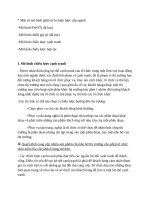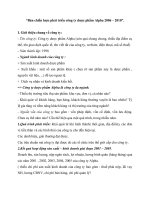Thuyết trình OLAP USING SSAS TO ANALYZE OLAP CUBE IN RETAIL DATABASE
Bạn đang xem bản rút gọn của tài liệu. Xem và tải ngay bản đầy đủ của tài liệu tại đây (475.3 KB, 31 trang )
OLAP & USING SSAS TO ANALYZE OLAP CUBE IN RETAIL
DATABASE
Group 9: Number Four
1. THANG MAI HOANG
2. TRAM TRAN THANH
3. LINH NGUYEN THI THUY
4. NGUYEN BUI BA
Advisor:
Associate Professor Phuc Do
INTRODUCTION
Hey Employee, how much money we made last year?
Employee: $1 billion dollars Sir !
How much did we make per year per quarter?
Which products did well and which failed?
What are the sales by region, country, by year, by quarter etc.
Employee (thinking ) : Hmm What is the best way to do this?? :=(
???
2
1. INTRODUCTION TO OLAP
2. OLAP CUBE
3. OLAP OPERATIONS
4. TYPE OF OLAP
5. OLAP ADVANTAGES & DISADVANTAGES
6. DATA WAREHOUSE
7. SQL SERVER ANALYSIS SERVICE
8. CASE STUDY
9. REFERENCES
10. Q/A
3
AGENDA
1. INTRODUCTION TO OLAP
4
•
The term OLAP was created as a slight modification of the traditional database term OLTP (Online
Transaction Processing)
•
Databases configured for OLAP employ a multidimensional data model, allowing for complex analytical and ad-
hoc queries with a rapid execution time
•
The first product that performed OLAP queries was Express, which was released in 1970 (and acquired by
Oracle in 1995 from Information Resources). However, the term did not appear until 1993 when it was
coined by Ted Codd, who has been described as "the father of the relational database
History
1. INTRODUCTION TO OLAP
5
What is OLAP?
•
OLAP (Online Analytical Processing) is computer processing that enables a user to easily
and selectively extract and view data from different points of view
•
OLAP allows users to analyze database information from multiple database systems at one
time
•
OLAP data is stored in multidimensional databases
1. INTRODUCTION TO OLAP
6
•
Some popular OLAP server software programs include: Oracle Express Server, Hyperion
Solutions Essbase
•
OLAP processing is often used for data mining
•
OLAP products are typically designed for multiple-user environments, with the cost of the
software based on the number of users
What is OLAP?
1. INTRODUCTION TO OLAP
7
•
To derive summarized information from large volume database
•
To generate automated reports for human view
Purpose of OLAP
1. INTRODUCTION TO OLAP
8
1. INTRODUCTION TO OLAP
9
•
Increasing data storage
•
Data versus Information
•
Data layout
Why do we need OLAP ?
2. THE OLAP CUBE
10
•
An OLAP Cube is a data structure that allows fast analysis of data
•
The arrangement of data into cubes overcomes a limitation of relational databases
•
The OLAP cube consists of numeric facts called measures which are categorized by
dimensions
•
A multidimensional cube can combine data from disparate data sources and store the information
in a fashion that is logical for business users
11
2. THE OLAP CUBE
12
2. THE OLAP CUBE
2. THE OLAP CUBE
13
3. OLAP OPERATIONS
14
Roll-up: move up the hierarchy
◦
e.g given total sales per city, we can
roll-up to get sales per state
Drill-down: move down the hierarchy
◦ more fine-grained aggregation
◦ lowest level can be the detail records
(drill-through)
category region year
product country quarter
state month week
city day
store
PRODUCT LOCATION TIME
3. OLAP OPERATIONS
15
Pivoting: aggregate on selected dimensions
◦
usually 2 dims (cross-tabulation)
3. OLAP OPERATIONS
16
Slice and Dice: select and project on one or more dimensions
p
r
o
d
u
c
t
customers
store
customer = “Smith”
4. TYPE OF OLAP
17
•
Relational OLAP(ROLAP)
•
Multidimensional OLAP(MOLAP)
•
Hybrid Online Analytical Processing (HOLAP)
5. OLAP ADVANTAGES & DISADVANTAGES
18
•
Offer quicker analysis
•
Great reporting tool
•
Improves decision making
•
Flexible
Advantages
•
Rely on data warehouse environment
•
Complexity of the queries
•
Result set be materialized in memory before
returning to the client
Disadvantages
6. DATA WAREHOUSE
19
Data warehouse (DW or DWH) is a system used for reporting and data analysis
A data warehouse is a subject-oriented, integrated, time-varying, non-volatile collection of
data that is used primarily in organizational decision making
6. DATA WAREHOUSE
20
Benefits
Provide a single common data model for all data of interest regardless of the data's
source.
Present the organization's information consistently
Enabling a central view across the enterprise
Maintain data history
Restructure the data so that it delivers excellent query performance, even for complex
analytic queries, without impacting the operational systems
Make decision–support queries easier to write
21
Data
Warehouse
Extract
Transform
Load
Refresh
OLAP Engine
Analysis
Query
Reports
Data mining
Monitor
&
Integrator
Metadata
Data Sources
Front-End Tools
Serve
Data Marts
Operational
DBs
other
sources
Data Storage
OLAP Server
Data warehousing architecture
6. DATA WAREHOUSE
22
Applications of data warehouses
Data Mining
Web Mining
Decision Support Systems (DSS)
6. DATA WAREHOUSE
23
Data warehouse design
•
Most data warehouses adopt a star schema to represent the multidimensional model
•
Each dimension is represented by a dimension-table
–
LOCATION(location_key,store,street_address,city,state, country,region)
–
dimension tables are not normalized
•
Transactions are described through a fact-table
–
each tuple consists of a pointer to each of the dimension-tables (foreign-key) and a list of measures (e.g.
sales $$$)
Fact Table
Location
Item Number
Buyer Number
Supplier Number
Time Period
Dollar Purchases
Unit Purchases
Dimension Table
Item Number
Item Name
Description
Category
Subcategory
Dimension Table
Buyer Number
Buyer Name
Department
Division
City
State
Region
Country
Dimension Table
Supplier Number
Supplier Name
Industry Category
Subcategory
State
Region
Country
Address
Dimension Table
Time Period
Date
Month
Year
Quarter
Fiscal Year
Day
Dimension Table
Location ID
Location Name
Budget
Storage Capacity
State
Region
Country
Address
24
At the center of the star is a single fact table that
represents the most important variable of interest
Star Schema
7. SQL SERVER ANALYSIS SERVICE
25
Olap with SQL Server Analysis Service
•
Microsoft SQL Server Analysis Services, SSAS, is an online analytical processing (OLAP), data
mining and reporting tool in Microsoft SQL Server. SSAS is used as a tool by organizations to
analyze and make sense of information possibly spread out across multiple databases, or in
disparate tables. Microsoft has included a number of services in SQL Server related to business
intelligence and data warehousing. These services include Integration Services and Analysis
Services. Analysis Services includes a group of OLAP and data mining capabilities









